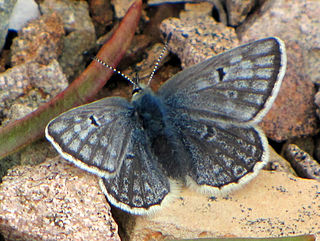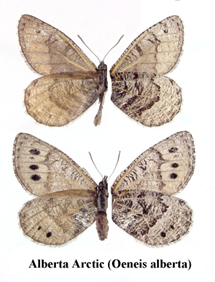
Oeneis is a butterfly genus of the Satyrinae. All but one of its members are Arctic, sub-Arctic or high-altitude alpine in distribution. Some of the members of the genus are among the butterflies that can get along in the harshest climates of any butterflies. Four species in Europe, more are found in Arctic Russia, Siberia, Mongolia, Arctic North America and the Rocky Mountains. Curiously, there are no observations from Greenland. The development of most species takes two years.

Oeneis chryxus, the chryxus Arctic or brown Arctic, is a butterfly of subfamily Satyrinae found in the far northwest regions of Canada and the United States. The brown Arctic has highly variable colorings, which tend toward light yellow to orange brown wings that help camouflage it against its mountainous rocky habitat. The larvae feed on local grasses and take two years to develop. This longer development period results in flights of adult brown Arctics only once every two years. The butterflies feed on nectar from various plants as their primary food source.

Oeneis jutta, the Jutta Arctic or Baltic grayling, is a species of butterfly in the subfamily Satyrinae with a Circumboreal distribution. It occurs in bogs and tundra in the north of Europe, the Baltic states, the Urals, Siberia, northern Kazakhstan, the Russian Far East, northern Mongolia, northeastern China, North Korea, and northern North America. Larvae feed on Carex and Eriophorum, possibly also Glyceria, Molinia, and Juncus. Ledum palustre is the preferred nectar plant of the adult butterflies. The species has one generation every one or two years, depending on the location.

Polygonia faunus, the green comma, Faunus comma, or Faunus anglewing is a butterfly of the family Nymphalidae.

Agriades glandon, the Arctic blue or Glandon blue, is a species of butterfly in the family Lycaenidae. It in found in Eurasia and North America.
Oeneis elwesi is a butterfly of the family Nymphalidae. It is found south of the Altai and Sayan Mountains and Mongolia.

Oeneis nevadensis is a species of butterfly in the family Nymphalidae. It is commonly known as the great Arctic, Nevada Arctic, great grayling, Felder's Arctic, or Pacific Arctic. It is native to northwestern North America.
Oeneis alpina, the sentinel Arctic or Eskimo Arctic, is a species of butterfly in the subfamily Satyrinae. It occurs in Siberia and the northern parts of North America.

Oeneis alberta, the Alberta Arctic, is a butterfly of the family Nymphalidae. It is found from the Canadian prairie provinces east to southern Manitoba. Isolated populations are found along the Rocky Mountains in Colorado, New Mexico and Arizona.

Oeneis tarpeja is a species of butterfly in the family Nymphalidae. It is found from the Caucasus and Volga region across Kazakhstan and southern Siberia to the Amur region and Mongolia. In Ukraine this species became extirpated in the mid-twentieth century. The habitat consists of steppe-clad plains and foothills.

Oeneis urda is a butterfly of the family Nymphalidae. It was described by Eduard Friedrich Eversmann in 1847. It is found from Russia to northern Mongolia, north-eastern China and Korea. The habitat consists of steppe-clad slopes.

Carterocephalus palaemon, the chequered skipper or arctic skipper, not to be confused with the large chequered skipper, is a species of woodland butterfly in the family Hesperiidae. This butterfly can live in grasslands. The upperside of the butterfly is brown with orange spots and on its underside the chequered skipper is orange with brown spots. Chequered skippers are found in Great Britain and other European regions, but seen locally in Japan and in North America. The size of the chequered skipper ranges from 19 to 32 mm with females being larger. In the 1970s, the chequered skipper went extinct in England due to the new management of the woodlands.

Oeneis bore, the white-veined Arctic or Arctic grayling, is a butterfly, a species of Satyrinae that occurs in North America and Asia.
Oeneis rosovi, the Philip's Arctic or early Arctic, is a species of butterfly in the subfamily Satyrinae. It occurs in Siberia and the northern parts of North America.
Oeneis polixenes, the Polixenes Arctic or Norique Alpin, is a species of butterfly in the subfamily Satyrinae. It has a Circumpolar distribution occurring in northern parts of North America the Arctic Urals, Kamtchatka, Yakutia, Chukchi Peninsula, and northern Siberia.
Oeneis tanana is a species of butterfly, a member of the Satyrinae. It occurs in Alaska, and is believed to be the only endemic species of butterfly in the state. It is speculated to be a hybrid species of Oeneis bore and O. chryxus. The species is threatened due to habitat loss.
The arctic Katahdin butterfly is a subspecies of the polixenes arctic. This particular butterfly is considered endangered because it only appears on Mount Katahdin in the State of Maine, and its small population fluctuates every year.










